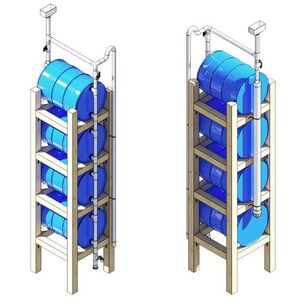Water collection systems: Difference between revisions
From
No edit summary |
No edit summary |
||
| Line 29: | Line 29: | ||
* [https://en.wikipedia.org/wiki/Rainwater_harvesting Wikipedia: Rainwater harvesting] | * [https://en.wikipedia.org/wiki/Rainwater_harvesting Wikipedia: Rainwater harvesting] | ||
* [https://github.com/google/h2e_technical_documentation Github: Google H2E] | * [https://github.com/google/h2e_technical_documentation Github: Google H2E] | ||
* [https://wiki.opensourceecology.org/wiki/Atmospheric_Water_Generator OpenSourceEcology: Atmospheric Water Generator] | |||
Revision as of 22:59, 21 March 2022
Project: Water collection systems
| Tools: | Wrenches |
|---|---|
| Parts: | Barrels, Nuts, Bolts, Frames, Hoses, Fluid pumps, Clamps, Couplers |
| Techniques: | Tri joints |
Introduction
Rainwater harvesting (RWH) is the collection and storage of rain, rather than allowing it to run off. Rainwater is collected from a roof-like surface and redirected to a tank, cistern, deep pit (well, shaft, or borehole), aquifer, or a reservoir with percolation, so that it seeps down and restores the ground water. Dew and fog can also be collected with nets or other tools. Rainwater harvesting differs from stormwater harvesting as the runoff is collected from roofs, rather than creeks, drains, roads, or any other land surfaces. Its uses include watering gardens, livestock, irrigation, domestic use with proper treatment, and domestic heating. The harvested water can also be committed to longer-term storage or groundwater recharge.
Challenges
Approaches
